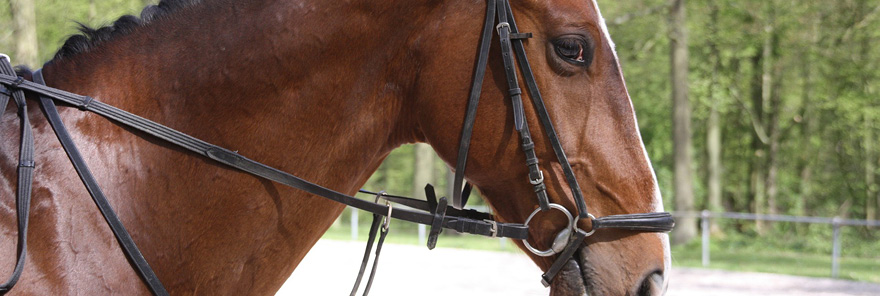At its most basic, the noseband’s purpose is to keep a horse’s mouth shut around the bit. A horse can evade the bit by gaping open his mouth, so nose pressure assists in keeping his mouth closed and adding a measure of control. However, one glance inside any tack room can tell you there are many different nosebands on the market. Use of these different nosebands can apply to certain training or behavioral applications, so let’s take a look at some common nosebands and their use.
Feature Photo: Drop noseband
The Plain Noseband or Cavesson is most commonly used on English bridles. When correctly fitted, the plain noseband sits about two fingers’ width below the horse’s cheekbone. This position provides gentle pressure around the horse’s jawbone, encouraging, but not forcing, the horse to keep his mouth closed around the bit. It also decreases the horse’s ability to cross his jaw, leveraging his jaws against pressure from the reins. The noseband can be used as an anchor for a standing martingale, but beyond this, it’s best for horses who don’t use their mouth or head to try and evade the bit or pull heavily on their rider.
The Flash Noseband is a loop of leather attached to the plain noseband at its top, center position on the horse’s nasal bone. It loops below the bit rings and rests just behind the horse’s chin, effectively pressing the horse’s mouth closed around the bit. The flash noseband is a basic way to deal with horses who might gape their mouth or cross their jaw to evade the bit, and can add some stability in high-pressure situations found in fast-paced disciplines such as show-jumping, when a horse evading the bit could run out of a jump or miss a sharp turn.
Because flash nosebands can hinder a horse’s breathing, they must be carefully fitted. You may find the plain noseband needs to be closer to the horse’s cheekbone in order to keep the flash portion from crossing the soft cartilage of the horse’s nose, which need room to expand when the horse is breathing hard.
The Drop Noseband lives up to its name by dropping far below the typical resting point of the plain noseband. It sits close to the bottom of the horse’s nasal bone, with its lower strap passing between the horse’s chin and the bit. The drop noseband keeps the horse’s mouth closed around the bit and discourages crossing the jaw, but it must be fitted carefully to avoid blocking the horse’s breathing.
The Figure-8 or Grackle Noseband looks like a flashy version of the flash noseband. Made of a figure-8 of leather, the lower half loops between the horse’s chin and bit like the flash noseband, but the upper half crosses the horse’s cheekbones and fastens much higher than the plain noseband would. The leather crosses in an X on the horse’s nasal bone, usually protected by a leather disc. This noseband is good for keeping the horse’s mouth closed without affecting the nasal passages, but it’s not as useful for keeping the horse from crossing his jaw. It’s primarily used in show-jumping and cross-country events, with dressage riders generally preferring a flash noseband.
When deciding which noseband to use on your horse’s bridle, consider what’s legal and traditional in the discipline you’ll be training in. It might not be legal to use a certain noseband in recognized competition, as is the case with figure-8 nosebands in hunter classes. Also consider just what your needs are. If you’re solely interested in keeping your horse’s mouth closed for increased communication during high-pressure events like show-jumping, the figure-8 might be the best choice. However, if your horse crosses his jaw to evade you, a flash noseband’s added pressure on the jawbone is probably a better choice. Always make sure you’re using the lightest noseband necessary for your needs, and pay close attention to how it fits your horse’s head. If you still have questions about the right noseband, we recommend talking with your trainer.


